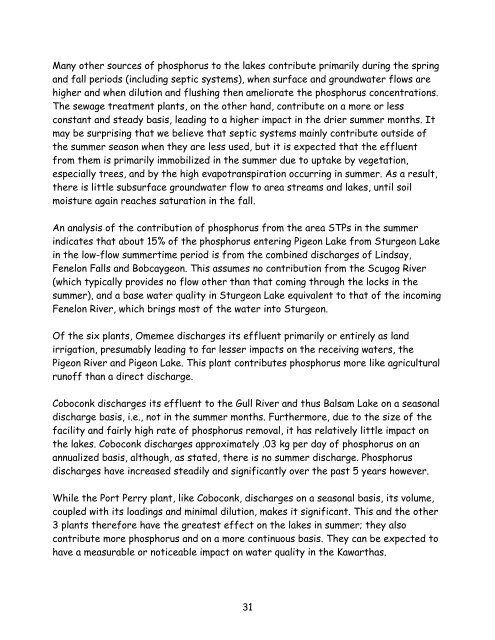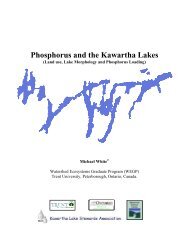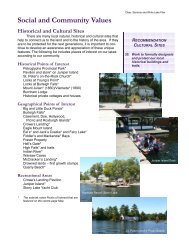Lake Water Quality 2006 Report - Lakefield Herald
Lake Water Quality 2006 Report - Lakefield Herald
Lake Water Quality 2006 Report - Lakefield Herald
You also want an ePaper? Increase the reach of your titles
YUMPU automatically turns print PDFs into web optimized ePapers that Google loves.
Many other sources of phosphorus to the lakes contribute primarily during the springand fall periods (including septic systems), when surface and groundwater flows arehigher and when dilution and flushing then ameliorate the phosphorus concentrations.The sewage treatment plants, on the other hand, contribute on a more or lessconstant and steady basis, leading to a higher impact in the drier summer months. Itmay be surprising that we believe that septic systems mainly contribute outside ofthe summer season when they are less used, but it is expected that the effluentfrom them is primarily immobilized in the summer due to uptake by vegetation,especially trees, and by the high evapotranspiration occurring in summer. As a result,there is little subsurface groundwater flow to area streams and lakes, until soilmoisture again reaches saturation in the fall.An analysis of the contribution of phosphorus from the area STPs in the summerindicates that about 15% of the phosphorus entering Pigeon <strong>Lake</strong> from Sturgeon <strong>Lake</strong>in the low-flow summertime period is from the combined discharges of Lindsay,Fenelon Falls and Bobcaygeon. This assumes no contribution from the Scugog River(which typically provides no flow other than that coming through the locks in thesummer), and a base water quality in Sturgeon <strong>Lake</strong> equivalent to that of the incomingFenelon River, which brings most of the water into Sturgeon.Of the six plants, Omemee discharges its effluent primarily or entirely as landirrigation, presumably leading to far lesser impacts on the receiving waters, thePigeon River and Pigeon <strong>Lake</strong>. This plant contributes phosphorus more like agriculturalrunoff than a direct discharge.Coboconk discharges its effluent to the Gull River and thus Balsam <strong>Lake</strong> on a seasonaldischarge basis, i.e., not in the summer months. Furthermore, due to the size of thefacility and fairly high rate of phosphorus removal, it has relatively little impact onthe lakes. Coboconk discharges approximately .03 kg per day of phosphorus on anannualized basis, although, as stated, there is no summer discharge. Phosphorusdischarges have increased steadily and significantly over the past 5 years however.While the Port Perry plant, like Coboconk, discharges on a seasonal basis, its volume,coupled with its loadings and minimal dilution, makes it significant. This and the other3 plants therefore have the greatest effect on the lakes in summer; they alsocontribute more phosphorus and on a more continuous basis. They can be expected tohave a measurable or noticeable impact on water quality in the Kawarthas.31





